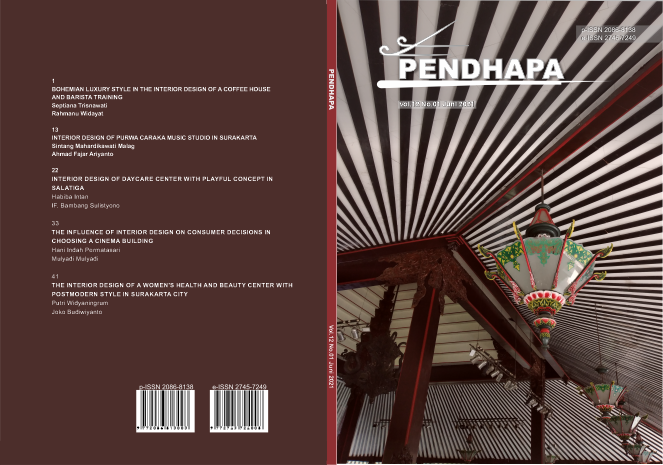The Influence of Interior Design on Consumer Decisions in Choosing a Cinema Building
DOI:
https://doi.org/10.33153/pendhapa.v12i1.3560Keywords:
interior, desain, bioskop, teaterAbstract
The global expansion of the film industry has an impact on the construction of cinema buildings, including in Indonesia. The construction of the cinema building must pay attention to the interior design, because the interior design will impact the comfort of visitors and create a desire to return at a later date. The purpose of this study was to determine if the interior design of a cinema influenced visitors' choice of a cinema building. According to the study results, the interior design of the cinema influences visitors' interest in choosing a cinema building, as well as what interior design factors influence them.Downloads
References
Abusaada, H. (2020). Cinematic Works-Based Affective Urban Design Atmospheres. In Global Issues and Innovative Solutions in Healthcare, Culture, and the Environment (pp. 120–132). IGI Global.
Alwindini, D. A., Fakhrunissa, R. A., & Luthfi, F. M. (2019). Motivasi Konsumen Dalam Menonton Film Di Bioskop (Bandung Raya). Prosiding Industrial Research Workshop and National Seminar, 10(1), 917–926.
Cuciaș, M. (2021). Designul de interior: istoricul și tendințele secolului XXI. Conferinţa Tehnico-Ştiinţifică a Studenţilor, Masteranzilor Şi Doctoranzilor, 1, 567–569.
Darmiyati Zuchdi, E. D., & Afifah, W. (2021). Analisis Konten Etnografi & Grounded Theory, dan Hermeneutika Dalam Penelitian (Vol. 314). Bumi Aksara.
Davis, P. (2006). Spatial competition in retail markets: movie theaters. The RAND Journal of Economics, 37(4), 964–982.
Fu, M., Liu, R., & Hon, C. K. H. (2020). Walkability evaluation of building circulation based on user preference. Engineering, Construction and Architectural Management.
Hogan, P. C. (2021). 3. Painterly Cinema: Three Minutes of Sin City. In Critical Approaches to the Films of Robert Rodriguez (pp. 63–80). University of Texas Press.
Mittal, N. (2021). The Key of Interior Design (Illustration of Methods and Principles). Standard Book House Since 1960.
Nuraini, D. (n.d.). Analisis penerimaan aplikasi mobile tix id menggunakan model utaut 2 extend anny mardjo. Fakultas Sains dan Teknologi UIN Syarif Hidayatullah Jakarta.
Saragih, M. G., Saragih, L., Purba, J. W. P., & Panjaitan, P. D. (2021). Metode Penelitian Kuantitatif: Dasar–Dasar Memulai Penelitian. Yayasan Kita Menulis.
Sumarno, S., & Indarto, I. (2018). Desain Show Room Bagi Para Perajin Rotan DS. Trangsan, Kec. Gatak, Kab. Sukoharjo. Pendhapa, 9(2). https://doi.org/https://doi.org/10.33153/pendhapa.v9i2.2419
Vargas, G. A., & Stevenson, F. (2014). Thermal Memory and Transition in Lobby Spaces. Energy Procedia, 62, 502–511. https://doi.org/10.1016/j.egypro.2014.12.412
Yang, B., Li, L., Song, C., Jiang, Z., & Ling, Y. (2021). Automatic interior layout with user-specified furniture. Computers & Graphics, 94, 124–131. https://doi.org/10.1016/j.cag.2020.11.006
Downloads
Published
Issue
Section
License
Authors who publish with Pendhapa agree to the following terms:
- Authors retain copyright and grant the journal right of first publication with the work simultaneously licensed under a Creative Commons Attribution License (CC BY-SA 4.0) that allows others to share the work with an acknowledgment of the work's authorship and initial publication in this journal.
- Authors are able to enter into separate, additional contractual arrangements for the non-exclusive distribution of the journal's published version of the work (e.g., post it to an institutional repository or publish it in a book), with an acknowledgment of its initial publication in this journal.
- Authors are permitted and encouraged to post their work online (e.g., in institutional repositories or on their website) prior to and during the submission process, as it can lead to productive exchanges, as well as earlier and greater citation of published work.

This work is licensed under a Creative Commons Attribution-ShareAlike 4.0 International License.









